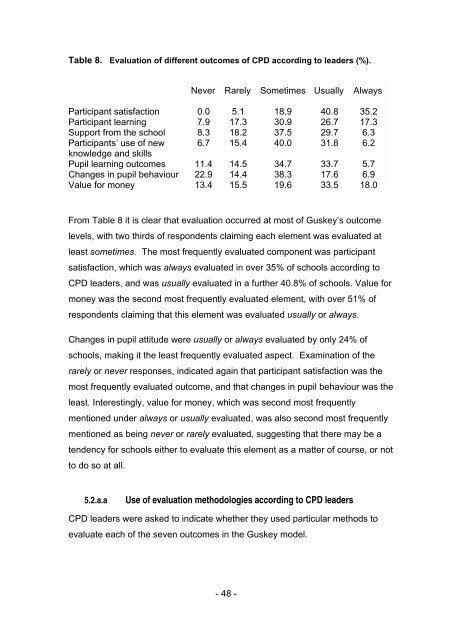Evaluating the Impact of Continuing Professional Development (CPD)
Evaluating the Impact of Continuing Professional Development (CPD)
Evaluating the Impact of Continuing Professional Development (CPD)
You also want an ePaper? Increase the reach of your titles
YUMPU automatically turns print PDFs into web optimized ePapers that Google loves.
Table 8. Evaluation <strong>of</strong> different outcomes <strong>of</strong> <strong>CPD</strong> according to leaders (%).<br />
Never Rarely Sometimes Usually Always<br />
Participant satisfaction 0.0 5.1 18.9 40.8 35.2<br />
Participant learning 7.9 17.3 30.9 26.7 17.3<br />
Support from <strong>the</strong> school 8.3 18.2 37.5 29.7 6.3<br />
Participants’ use <strong>of</strong> new 6.7 15.4 40.0 31.8 6.2<br />
knowledge and skills<br />
Pupil learning outcomes 11.4 14.5 34.7 33.7 5.7<br />
Changes in pupil behaviour 22.9 14.4 38.3 17.6 6.9<br />
Value for money 13.4 15.5 19.6 33.5 18.0<br />
From Table 8 it is clear that evaluation occurred at most <strong>of</strong> Guskey’s outcome<br />
levels, with two thirds <strong>of</strong> respondents claiming each element was evaluated at<br />
least sometimes. The most frequently evaluated component was participant<br />
satisfaction, which was always evaluated in over 35% <strong>of</strong> schools according to<br />
<strong>CPD</strong> leaders, and was usually evaluated in a fur<strong>the</strong>r 40.8% <strong>of</strong> schools. Value for<br />
money was <strong>the</strong> second most frequently evaluated element, with over 51% <strong>of</strong><br />
respondents claiming that this element was evaluated usually or always.<br />
Changes in pupil attitude were usually or always evaluated by only 24% <strong>of</strong><br />
schools, making it <strong>the</strong> least frequently evaluated aspect. Examination <strong>of</strong> <strong>the</strong><br />
rarely or never responses, indicated again that participant satisfaction was <strong>the</strong><br />
most frequently evaluated outcome, and that changes in pupil behaviour was <strong>the</strong><br />
least. Interestingly, value for money, which was second most frequently<br />
mentioned under always or usually evaluated, was also second most frequently<br />
mentioned as being never or rarely evaluated, suggesting that <strong>the</strong>re may be a<br />
tendency for schools ei<strong>the</strong>r to evaluate this element as a matter <strong>of</strong> course, or not<br />
to do so at all.<br />
5.2.a.a<br />
Use <strong>of</strong> evaluation methodologies according to <strong>CPD</strong> leaders<br />
<strong>CPD</strong> leaders were asked to indicate whe<strong>the</strong>r <strong>the</strong>y used particular methods to<br />
evaluate each <strong>of</strong> <strong>the</strong> seven outcomes in <strong>the</strong> Guskey model.<br />
- 48 -

















